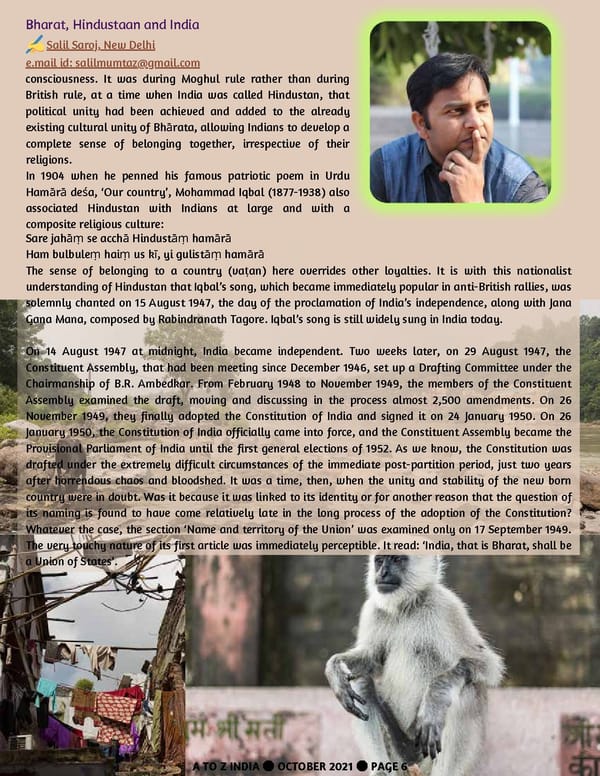Bharat, Hindustaan and India Salil Saroj, New Delhi e.mail id: [email protected] consciousness. It was during Moghul rule rather than during British rule, at a time when India was called Hindustan, that political unity had been achieved and added to the already existing cultural unity of Bhārata, allowing Indians to develop a complete sense of belonging together, irrespective of their religions. In 1904 when he penned his famous patriotic poem in Urdu Hamārā deśa, ‘Our country’, Mohammad Iqbal (1877-1938) also associated Hindustan with Indians at large and with a composite religious culture: Sare jahāṃ se acchā Hindustāṃ hamārā Ham bulbuleṃ haiṃ us kī, yi gulistāṃ hamārā The sense of belonging to a country (vaṭan) here overrides other loyalties. It is with this nationalist understanding of Hindustan that Iqbal’s song, which became immediately popular in anti-British rallies, was solemnly chanted on 15 August 1947, the day of the proclamation of India’s independence, along with Jana Gana Mana, composed by Rabindranath Tagore. Iqbal’s song is still widely sung in India today. On 14 August 1947 at midnight, India became independent. Two weeks later, on 29 August 1947, the Constituent Assembly, that had been meeting since December 1946, set up a Drafting Committee under the Chairmanship of B.R. Ambedkar. From February 1948 to November 1949, the members of the Constituent Assembly examined the draft, moving and discussing in the process almost 2,500 amendments. On 26 November 1949, they finally adopted the Constitution of India and signed it on 24 January 1950. On 26 January 1950, the Constitution of India officially came into force, and the Constituent Assembly became the Provisional Parliament of India until the first general elections of 1952. As we know, the Constitution was drafted under the extremely difficult circumstances of the immediate post-partition period, just two years after horrendous chaos and bloodshed. It was a time, then, when the unity and stability of the new born country were in doubt. Was it because it was linked to its identity or for another reason that the question of its naming is found to have come relatively late in the long process of the adoption of the Constitution? Whatever the case, the section ‘Name and territory of the Union’ was examined only on 17 September 1949. The very touchy nature of its first article was immediately perceptible. It read: ‘India, that is Bharat, shall be a Union of States’. A TO Z INDIA ● OCTOBER 2021 ● PAGE 6
 A TO Z INDIA - OCTOBER 21 Page 5 Page 7
A TO Z INDIA - OCTOBER 21 Page 5 Page 7